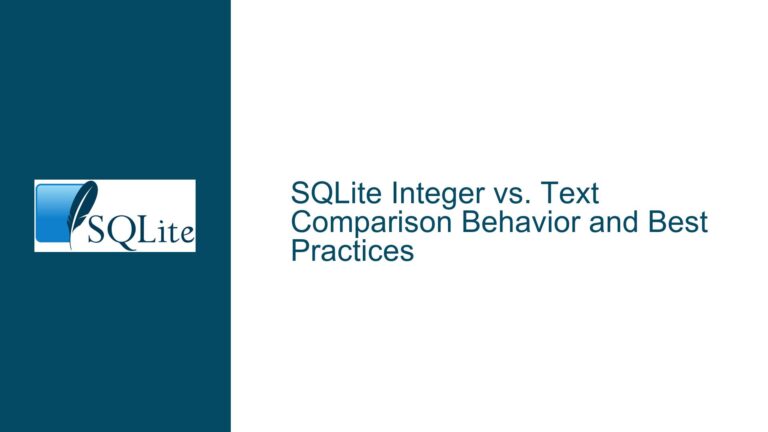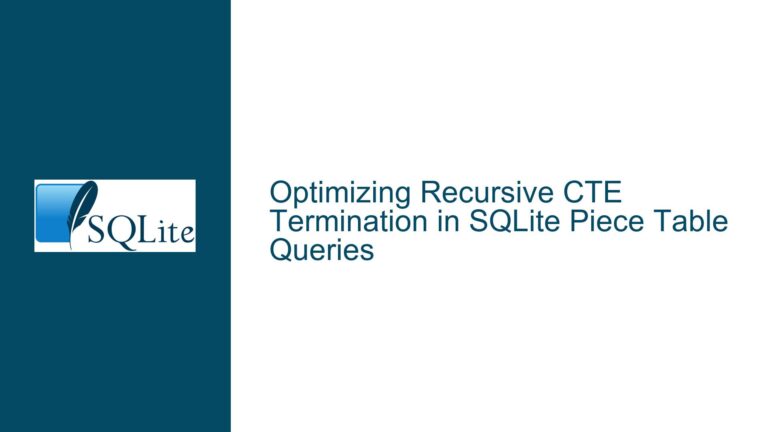Updating Nested JSON Arrays in SQLite: Challenges and Solutions
Understanding JSON Array Updates in SQLite
SQLite’s support for JSON through the json1 extension has made it a versatile tool for handling semi-structured data. However, updating nested JSON arrays within a column can be tricky, especially when the goal is to modify specific elements within the array based on certain conditions. This issue arises because SQLite treats JSON data as text, and operations like json_set or json_replace require careful handling to avoid unintended side effects, such as overwriting the entire JSON structure or failing to update multiple matching elements.
The core challenge lies in the fact that SQLite’s JSON functions do not natively support in-place updates of JSON arrays. Instead, you must reconstruct the JSON array with the desired modifications. This process involves extracting the array, iterating through its elements, applying the necessary changes, and then reassembling the array. While this approach is functional, it can be complex and error-prone, particularly when dealing with large or deeply nested JSON structures.
Common Pitfalls When Updating JSON Arrays
One of the most common pitfalls is the inadvertent replacement of the entire JSON array with a single modified element. This occurs when the json_set function is used without properly reconstructing the array. For example, if you attempt to update a specific key within a JSON object inside an array, the result might be a single JSON object instead of the original array. This happens because the json_set function operates on individual JSON values, not on arrays as a whole.
Another issue is the inability to update multiple elements within the array in a single operation. If multiple elements match the update criteria, a naive approach might only update the first matching element, leaving the rest unchanged. This limitation stems from the way SQLite processes JSON data and the lack of built-in mechanisms for batch updates within JSON arrays.
Additionally, the use of json_each to iterate through JSON arrays can introduce complexity, especially when combined with json_set or json_replace. The json_each function returns a table-like structure, which must be carefully integrated into the update logic to ensure that the original array is preserved and correctly modified.
Step-by-Step Solutions for Updating JSON Arrays
To address these challenges, a structured approach is required. Below, we outline a step-by-step method for updating nested JSON arrays in SQLite, ensuring that all matching elements are modified and the original array structure is preserved.
Step 1: Extract and Iterate Through the JSON Array
The first step is to extract the JSON array and iterate through its elements using the json_each function. This function returns a table with columns for the key, value, and other properties of each JSON element. By joining this table with the original table, you can access and modify individual elements within the array.
For example:
SELECT json_each.key, json_each.value
FROM orders, json_each(orders.items)
WHERE orders.id = 1;
This query retrieves each element of the items JSON array for the order with id = 1.
Step 2: Apply Conditional Updates to JSON Elements
Once you have access to individual JSON elements, you can apply conditional updates using the json_set function. This function allows you to modify specific keys within a JSON object while preserving the rest of the structure. To ensure that only the desired elements are updated, use a CASE statement to apply the changes conditionally.
For example:
SELECT json_each.key,
CASE
WHEN json_extract(json_each.value, '$.supplier') = 'XXX'
THEN json_set(json_each.value, '$.brand_', 'Teq')
ELSE json_each.value
END AS updated_value
FROM orders, json_each(orders.items)
WHERE orders.id = 1;
This query updates the brand_ key to 'Teq' for all elements where the supplier is 'XXX'.
Step 3: Reconstruct the JSON Array
After modifying the individual elements, the next step is to reconstruct the JSON array. This is done using the json_group_array function, which aggregates the modified elements into a single JSON array. The reconstructed array can then be used to update the original table.
For example:
WITH updated_items AS (
SELECT json_each.key,
CASE
WHEN json_extract(json_each.value, '$.supplier') = 'XXX'
THEN json_set(json_each.value, '$.brand_', 'Teq')
ELSE json_each.value
END AS updated_value
FROM orders, json_each(orders.items)
WHERE orders.id = 1
)
UPDATE orders
SET items = (SELECT json_group_array(updated_value) FROM updated_items)
WHERE id = 1;
This query updates the items column for the order with id = 1, replacing the original JSON array with the modified version.
Step 4: Handle Multiple Updates Efficiently
If multiple elements within the JSON array need to be updated, the above approach ensures that all matching elements are modified. However, if the updates are complex or involve multiple conditions, consider breaking the process into smaller steps or using additional CTEs (Common Table Expressions) to manage the logic.
For example:
WITH filtered_items AS (
SELECT json_each.key, json_each.value
FROM orders, json_each(orders.items)
WHERE orders.id = 1
),
updated_items AS (
SELECT key,
CASE
WHEN json_extract(value, '$.supplier') = 'XXX'
THEN json_set(value, '$.brand_', 'Teq')
ELSE value
END AS updated_value
FROM filtered_items
)
UPDATE orders
SET items = (SELECT json_group_array(updated_value) FROM updated_items)
WHERE id = 1;
This query first filters the JSON elements and then applies the updates, ensuring that the process is both efficient and easy to understand.
Best Practices for Managing JSON Data in SQLite
While the above steps provide a solution for updating JSON arrays, it’s important to consider best practices for managing JSON data in SQLite to avoid common pitfalls and ensure optimal performance.
Normalize Data When Possible
Although JSON provides flexibility, it is not always the best choice for storing structured data. If the JSON array represents a collection of related entities, consider normalizing the data into separate tables. For example, instead of storing order items as a JSON array, create a separate order_items table with a foreign key reference to the orders table. This approach simplifies updates and queries, as SQLite’s relational features can be leveraged more effectively.
Use Views for Complex Queries
If normalization is not feasible, consider using views to simplify queries involving JSON data. A view can encapsulate the logic for extracting and transforming JSON data, making it easier to work with in subsequent queries. For example, you could create a view that extracts the items array into a tabular format, allowing you to query and update the data using standard SQL syntax.
Optimize JSON Functions
When working with JSON functions, be mindful of performance implications. Functions like json_each and json_group_array can be resource-intensive, especially with large datasets. To optimize performance, limit the scope of JSON operations to the necessary subset of data and avoid unnecessary iterations or transformations.
Test Thoroughly
Given the complexity of JSON operations, thorough testing is essential. Ensure that your update logic handles all edge cases, such as missing keys, null values, and deeply nested structures. Use test data that reflects the diversity of your actual data to validate the correctness and robustness of your queries.
Conclusion
Updating nested JSON arrays in SQLite requires a careful and structured approach to avoid common pitfalls and ensure accurate results. By extracting and iterating through the JSON array, applying conditional updates, and reconstructing the array, you can achieve the desired modifications while preserving the original structure. Additionally, following best practices such as normalizing data, using views, optimizing JSON functions, and thorough testing can help you manage JSON data effectively in SQLite. While the process may seem complex, the flexibility and power of SQLite’s JSON support make it a valuable tool for handling semi-structured data in a relational database context.






